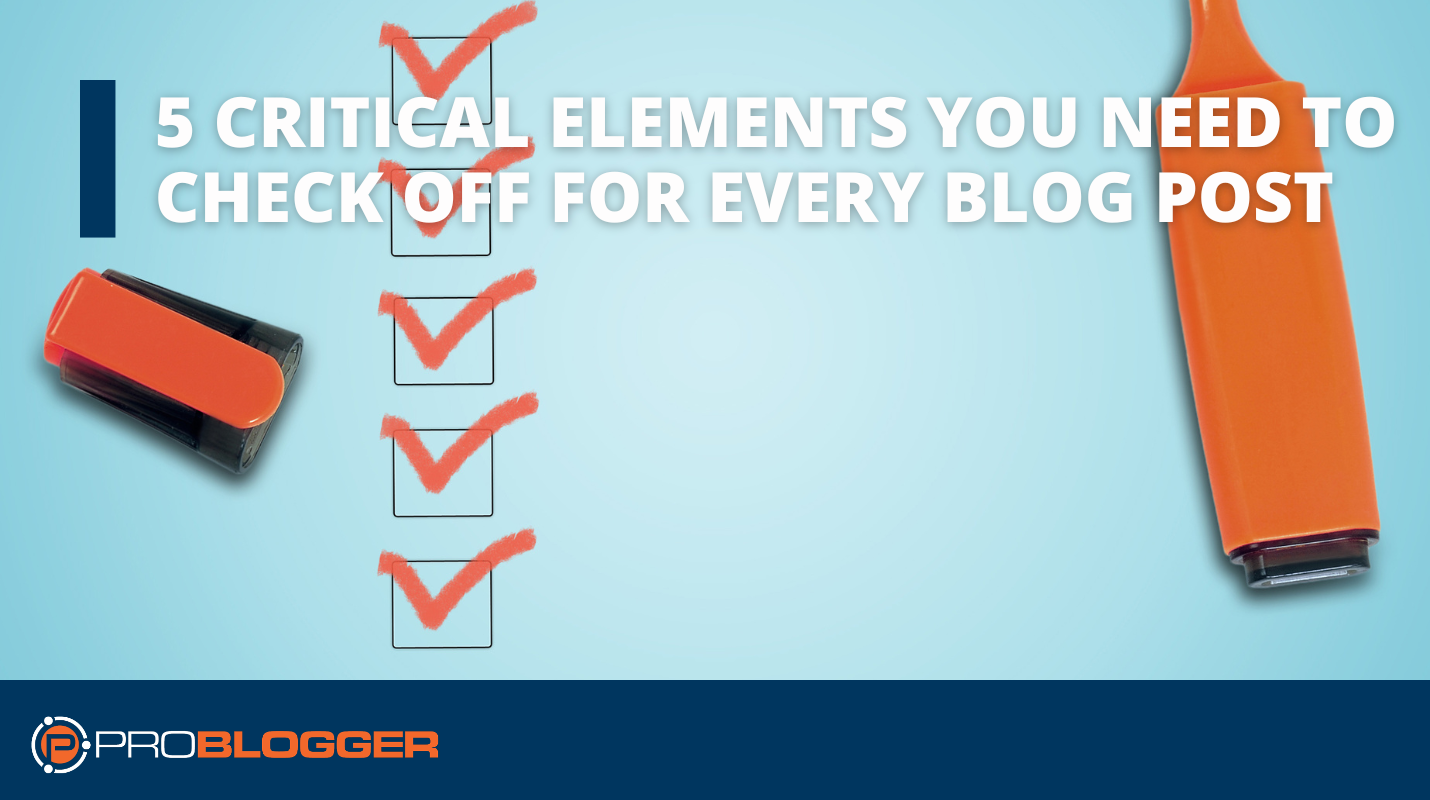

This post is by ProBlogger subject matter expert Ali Luke
Over the past few years, I’ve conducted a lot of blog reviews for fellow writers. It’s always great fun to read other people’s posts … especially when they’re on topics that are totally new to me!
Along the way, though, I’ve noticed that there are five critical elements that far too many bloggers miss out of their posts.
Could your posts be missing any of these too?
They are:
1. The Hook
2. Subheadings
3. Transitions
4. Links
5. The Conclusion
#1: The Hook
I’ve never seen a blog post that didn’t have an introduction. I’ve seen plenty of posts, though, that had over-long introductions without a hook: a compelling reason for the reader to keep going.
Here’s an example of a good hook, from Laney Galligan’s post 5 Ways You Can Use Facebook Groups to Benefit Your Blog:
That’s right, more than 1 billion people are using Facebook groups. That’s where the conversation and community is happening and it’s something you can easily create for your blog.
Laney makes the benefits clear (Facebook is where “the conversation and community is happening”) and also makes an implicit promise that this post will teach the reader how to “easily create [that] for your blog”.
The first few sentences of your post, too, need to convince the reader that your post is worth their time.
#2: Subheadings
Very short blog posts (say, under 400 words) don’t need subheadings. Anything longer, though, can normally benefit from being broken into sections.
If your post is missing subheadings, it’s easy for the reader to get lost midway. When that happens, chances are, they’ll stop reading. Subheadings help because they act like signposts: they tell the reader where they are and what’s coming next.
For more help with subheadings, check out my podcast for ProBlogger, How to Use Subheadings to Add Structure to Your Blog Posts.
#3: Transitions
A transition is like a little bridge from one thought to another. Sometimes, you don’t need a transition at all (a subheading can essentially serve the same purpose). If your post feels disjointed or abrupt in places, though, you may need to add in a quick transition.
Often, a transition is helpful before any major new section of your post. They can also be used to introduce lists.
Here are some examples, from Nicole Avery’s post How to Reduce Your Time on Social Media to Increase Your Blogging Productivity – you might want to read the whole post to see how these work in context:
There are two different ways that I see social media impact bloggers’ productivity negatively.
How does this behaviour on social media impact their productivity? It impacts it in three key ways:
It doesn’t mean that you can’t be on social media, it just means you need to take a more planned and proactive approach to how you go about it. Here are two actions you can take to help you:
#4: Links
While it’s not absolutely essential for your post to contain links, it’s almost always a good idea to include at least one. Both internal links (to your own blog) and external links (to other websites) matter.
- Links to past posts on your blog help readers dig in … and stick around.
- Links to posts on other people’s blogs position you as someone helpful and knowledgeable.
- Links to your products or services help you make more sales.
- Links to books on Amazon can bring in affiliate income – and also make you look helpful and well informed.
It’s often appropriate to include links throughout your post, usually to give more information about a particular point. If you quote someone or give an example, you should provide a link too.
Sometimes, you might not have many opportunities to link within a post (or you may not want to distract readers – e.g. in a how-to post): if that’s the case, you could include some “further reading” or “where next?” suggestions at the end.
#5: The Conclusion
Of all the missing elements, this is probably the one that seems to get left off the most! If you finish your post too suddenly, though, it not only seems weirdly abrupt to readers … it robs you of a great chance to direct their next actions.
There are several ways to tackle the conclusion: personally, I think it’s good to sum up briefly (if only in a sentence), and to give a “call to action”. You can find out more about those in the ProBlogger podcast episode How to Write a Post That Contains a Call to Action.
Here’s an example of a conclusion that encourages the reader to take action based on the content – this is from Colin Gray’s post How to Get Your First Podcast Sponsorship:
If you’re looking to dip your toe in the waters, but sponsoring your blog is a step too far, then try your podcast. Build a relationship there and who knows, it might lead to your blog, your video channel, your social media.
If that gives you the time and the space to spend time on the content you love, offering more and more value to your readers, then it’s worth an ad spot or two. Give it a shot!
When you’re busy writing a blog post, it can be difficult to think about everything you need to include … you’re probably hurrying just to get all your ideas down.
As you edit, though, use these five critical elements as a checklist: make sure you’ve included each one – or that you’ve got a very good reason not to!
Which of these five elements do you find yourself inadvertently missing out? How could you include it in your next post? Share your thoughts or tips with us in the comments!










